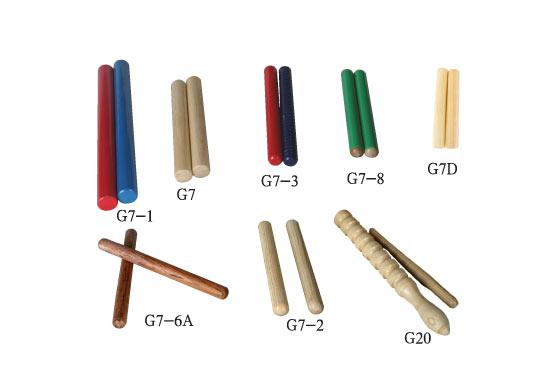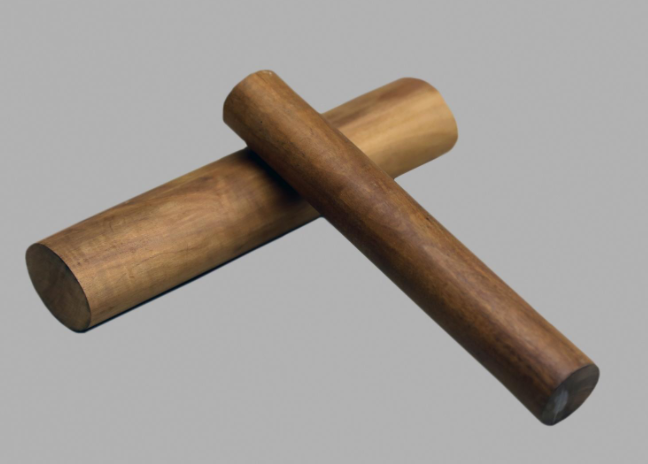The specific type of clapper
730 views · Organized by 向日葵 on 2022-03-03
Bangzi is used in all kinds of Chinese national bands. It was first used to accompany various Bangzi tunes and got its name. It is often used in strong beats to increase the dramatic atmosphere. Around the 17th century (the late Ming and early Qing dynasties), it became popular with the rise of Bangzi Opera, which can be divided into Hebei Bangzi, Nanbangzi, Zuobang and Qin Bang. Bangzi sometimes refers specifically to Hebei Bangzi.
Hebei Bangzi is popular in the Shanxi, Shaanxi, Hebei and Henan regions. Bangzi opera and folk instrumental music are used in ensembles. It is mostly made of red sandalwood, mahogany or jujube wood. Two hardwood sticks of different lengths and thicknesses, the slender one is cylindrical, 25 cm long and 4 cm in diameter; the short and thick one is rectangular, 20 cm long, 5-6 cm wide, and 4 cm thick.
Nanbangzi, also known as Cantonese board, is widely popular in the southern region and is used in opera and folk instrumental ensembles, as well as the accompaniment of Peking Opera high-plectrum singing. Mostly made of rosewood. It is a rectangular hollow body with a rectangular sound hole in the middle.
The falling bang, also known as the pedal bang, is used for the accompaniment of the Henan Opera and the Henan pendant. The shape is like a duck egg, and the bang and the mallet are connected as one. Qin Bang is used for Qin Opera accompaniment. Oval, 20 cm long.
When playing, hold a rectangular stick in the left hand and a round wooden stick in the right hand, and strike each other to make sounds. The timbre is crisp, high-pitched and solid, with no fixed pitch. It is an important accompaniment instrument for Bangzi opera, and is often used to regularly strike strong beats. It is also often used in some folk instrumental ensembles and is popular in Hebei, Henan and Shandong.
Nanbangzi is popular in southern my country. It was originally an accompaniment instrument for Cantonese Opera, and later it was also used for Peking Opera Gaobazi's singing accompaniment and Cantonese music. The pronunciation is short and mellow. In addition to hitting strong beats in opera accompaniment and instrumental ensembles, it can also be used to express special sound effects such as the sound of horse hooves and machine gun shooting.
There is a wooden tenon at the waist of the falling bang, which is fixed on a standing stick, and there is another tenon groove on the standing stick. By stepping on the foot, control the sound of the wooden chuan and the bang. When playing, it is often tied to the legs of the table and played by the accompanist who plays the pendant.
Hebei Bangzi is popular in the Shanxi, Shaanxi, Hebei and Henan regions. Bangzi opera and folk instrumental music are used in ensembles. It is mostly made of red sandalwood, mahogany or jujube wood. Two hardwood sticks of different lengths and thicknesses, the slender one is cylindrical, 25 cm long and 4 cm in diameter; the short and thick one is rectangular, 20 cm long, 5-6 cm wide, and 4 cm thick.
Nanbangzi, also known as Cantonese board, is widely popular in the southern region and is used in opera and folk instrumental ensembles, as well as the accompaniment of Peking Opera high-plectrum singing. Mostly made of rosewood. It is a rectangular hollow body with a rectangular sound hole in the middle.
The falling bang, also known as the pedal bang, is used for the accompaniment of the Henan Opera and the Henan pendant. The shape is like a duck egg, and the bang and the mallet are connected as one. Qin Bang is used for Qin Opera accompaniment. Oval, 20 cm long.

Hebei Bang
Also known as "bang board". Consists of two solid hardwood rods of varying lengths and thicknesses. Generally, it is made of red sandalwood and mahogany. In some places, it is also made of jujube heart. One is round with a length of 25 cm and a diameter of 4 cm, and the other short and thick is rectangular, 20 cm long and 5-6 cm wide. 4 cm thick.When playing, hold a rectangular stick in the left hand and a round wooden stick in the right hand, and strike each other to make sounds. The timbre is crisp, high-pitched and solid, with no fixed pitch. It is an important accompaniment instrument for Bangzi opera, and is often used to regularly strike strong beats. It is also often used in some folk instrumental ensembles and is popular in Hebei, Henan and Shandong.

Nanbangzi
Also known as Bu fish, Guangdong plate. "Continued Documents of the Qing Dynasty": "The use of fish is equal to drumming or acting as a clapper, and it is also a musical instrument in the south." A rectangular wooden hollow body, 24.5 cm long, 8.7 cm wide, and 6 cm thick, with a rectangular sound in the middle. hole. It is better to use rosewood, and the sound holes must be neatly arranged and the inner chamber smooth. When playing, the left hand holds the bang and the right hand holds a bamboo stick or wooden shovel to strike.Nanbangzi is popular in southern my country. It was originally an accompaniment instrument for Cantonese Opera, and later it was also used for Peking Opera Gaobazi's singing accompaniment and Cantonese music. The pronunciation is short and mellow. In addition to hitting strong beats in opera accompaniment and instrumental ensembles, it can also be used to express special sound effects such as the sound of horse hooves and machine gun shooting.
fall
Also known as "foot clapper". Wooden ball. Shaped like a duck egg, the diameter of the circle is 9 cm and it is hollow. It is divided into three kinds of large, medium and small, with lengths of 13.5, 11.5 and 10 cm, and diameters of 9.5, 8.5 and 5 cm, respectively. There is a wooden tenon at the waist, which is fixed vertically on a standing stick. There is another tenon and groove below, and the center crosses a shaft to connect the hammer and the pull rope respectively. It is used for the accompaniment of Henan opera and Henan pendant book.There is a wooden tenon at the waist of the falling bang, which is fixed on a standing stick, and there is another tenon groove on the standing stick. By stepping on the foot, control the sound of the wooden chuan and the bang. When playing, it is often tied to the legs of the table and played by the accompanist who plays the pendant.

Qin Bang
For Qin Opera accompaniment. The shape is oval, 20 cm long.Involving musical instruments
Bangzi (pinyin: bāng zi), also known as bangban, is a Chinese percussion instrument. Around the late Ming and early Qing Dynasties (17th century) in China, it became popular with the rise of Bangzi Opera. The clapper consists of two solid hardwood rods of varying lengths and thicknesses.
Bamboo tied (pinyin: Zhú bāng) is a musical instrument of the Jing people. It is popular in Wanwei, Shanxin, Wutou and other places in Fangcheng County of Guangxi Zhuang Autonomous Region. Generally used to celebrate the arrival of festivals.
Guess you like
Organized by 肖毅 on 2022-03-09
"Joke Tan" is a form of folk singing, which has the form of opera. Its performances are often interspersed in the middle of Meihu plays, appearing at the request of the audience.
read >>
Organized by 卷鹅 on 2022-03-03
A ringer used by ancient patrols or yamen to collect and disperse people's knocks. Made of bamboo or hollowed out wood. The second chapter of "Water Margin": "In the front and back of Zhuang, Zhuangdong and Zhuangxi, three or four hundred Shijiazhuang households heard the sound of bangs, all dragged guns and sticks, gathered three or four hundred people, and all went to Shijiazhuang ."
read >>
 渝公网安备 50010702504639号
渝公网安备 50010702504639号